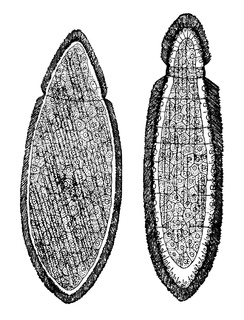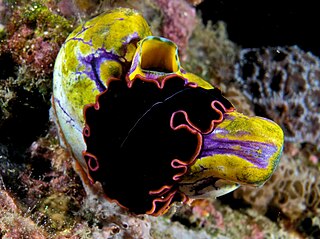
The flatworms, flat worms, Platyhelminthes, or platyhelminths are a phylum of relatively simple bilaterian, unsegmented, soft-bodied invertebrates. Unlike other bilaterians, they are acoelomates, and have no specialized circulatory and respiratory organs, which restricts them to having flattened shapes that allow oxygen and nutrients to pass through their bodies by diffusion. The digestive cavity has only one opening for both ingestion and egestion ; as a result, the food cannot be processed continuously.

Orthonectida is a small phylum of poorly known parasites of marine invertebrates that are among the simplest of multi-cellular organisms. Members of this phylum are known as orthonectids.

A planarian is one of many flatworms of the traditional class Turbellaria. It usually describes free-living flatworms of the order Tricladida (triclads), although this common name is also used for a wide number of free-living platyhelminthes. Planaria are common to many parts of the world, living in both saltwater and freshwater ponds and rivers. Some species are terrestrial and are found under logs, in or on the soil, and on plants in humid areas.

Monogeneans are a group of ectoparasitic flatworms commonly found on the skin, gills, or fins of fish. They have a direct lifecycle and do not require an intermediate host. Adults are hermaphrodites, meaning they have both male and female reproductive structures.

Acoelomorpha is a subphylum of very simple and small soft-bodied animals with planula-like features which live in marine or brackish waters. They usually live between grains of sediment, swimming as plankton, or crawling on other organisms, such as algae and corals. With the exception of two acoel freshwater species, all known Acoelomorphs are marine.

The New Zealand flatworm is a large land flatworm native to New Zealand. It can vary from 5 mm in length when hatched to approximately 17 centimetres (6.7 in) in mature adults.

Pseudocerotidae is a family of flatworms which includes the Bedford's flatworm.

Geoplanidae is a family of flatworms known commonly as land planarians or land flatworms.

Platydemus manokwari, also known as the New Guinea flatworm, is a species of large predatory land flatworm.

The Lecithoepitheliata are an order of rhabditophoran flatworms. They are free-living worms, found in both freshwater and marine environments.
Neoophora is a group of rhabditophoran flatworms with ectolecithal eggs, i.e., yolk is not present in the egg as in most animals, but rather is secreted by accessory glands called vitellaria or yolk glands. These glands have the same embryonic origin as the ovaries, but usually constitute a separate organ in adult animals.

Cotylea is a suborder of free-living marine turbellarian flatworms in the order Polycladida.

Prosthiostomidae is a family of free-living marine polyclad flatworms in the suborder Cotylea.
Amakusaplana acroporae, the Acropora-eating flatworm or AEFW, is a species of free-living marine polyclad flatworms in the genus Amakusaplana.

Neodermata is a clade of rhabditophoran flatworms containing the parasitic groups Trematoda, Monogenea and Cestoda.
Rhabditophora is a class of flatworms. It includes all parasitic flatworms and most free-living species that were previously grouped in the now obsolete class Turbellaria. Therefore, it contains the majority of species in the phylum Platyhelminthes, excluding only the catenulids, to which they appear to be the sister group.

Rhabdocoela is an order of flatworms in the class Rhabditophora with about 1700 species described worldwide. Most of rhabdocoels are free-living organisms, but some live symbiotically with other animals.

Trepaxonemata is a subclass of the Platyhelminthes or flatworms. It includes all parasitic flatworms and several free-living species that were previously grouped in the now obsolete class Turbellaria. Therefore, it contains the majority of species in the phylum Platyhelminthes, excluding the Catenulida, and the Macrostomorpha.
Bothrioneodermata is a clade of flatworms containing the Bothrioplanida and the Neodermata.
Endozoicomonas acroporae is a Gram-negative, rod-shaped, aerobic and non-motile bacterium from the genus of Endozoicomonas which has been isolated from the coral Acropora.














